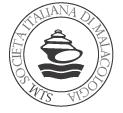The “Bothropoma” species in the Red Sea
Bruno Sabelli*
* Via del Borgo di San
Pietro 14, 40126 Bologna,
Italy,
This email address is being protected from spambots. You need JavaScript enabled to view it.
Pietro 14, 40126 Bologna,
Italy,
This email address is being protected from spambots. You need JavaScript enabled to view it.
Abstract
The use of the genus Bothropoma for Red Sea colloniid species is incorrect. Of the four presumptive Red Sea species one of them usually indicated as Bothropoma bellula (H. Adams, 1873) is not a Colloniinae but probably belongs to the subfamily Liotopomatinae and is here considered a junior synonym of Depressipoma (?) pentegoniostoma (Carpenter, 1856). The shells of the other species are to be attributed to the genus Neocollonia and are very variable, but in general they can be distinguished on the basis of the development of three major spiral cords of the body whorl: Neocollonia pilula (Dunker, 1860) has a rounded profile without any protruding spiral cord and Neocollonia isseli (Thiele, 1924) has a rounded/angulated shell mainly with first spiral cord here termed number 1 protruding. These two Neocollonia may even be extreme morphs of the same species, but only molecular investigation will allow testing this hypothesis.Neocollonia munda (H. Adams, 1873) has a slightly flattened body whorl with similarly prominent spiral cords here named number 2 and 3. I consider the recently described species Neocollonia diversicolor, N. splendida and N. kantori (all Poppe Tagaro & Huang, 2023) within the intraspecific variation of N. pilula and thus junior synonyms.
Key words
Bothropoma, Neocollonia, Liotopomatinae, Red Sea, shell morphology, systematics.
The use of the genus Bothropoma for Red Sea colloniid species is incorrect. Of the four presumptive Red Sea species one of them usually indicated as Bothropoma bellula (H. Adams, 1873) is not a Colloniinae but probably belongs to the subfamily Liotopomatinae and is here considered a junior synonym of Depressipoma (?) pentegoniostoma (Carpenter, 1856). The shells of the other species are to be attributed to the genus Neocollonia and are very variable, but in general they can be distinguished on the basis of the development of three major spiral cords of the body whorl: Neocollonia pilula (Dunker, 1860) has a rounded profile without any protruding spiral cord and Neocollonia isseli (Thiele, 1924) has a rounded/angulated shell mainly with first spiral cord here termed number 1 protruding. These two Neocollonia may even be extreme morphs of the same species, but only molecular investigation will allow testing this hypothesis.Neocollonia munda (H. Adams, 1873) has a slightly flattened body whorl with similarly prominent spiral cords here named number 2 and 3. I consider the recently described species Neocollonia diversicolor, N. splendida and N. kantori (all Poppe Tagaro & Huang, 2023) within the intraspecific variation of N. pilula and thus junior synonyms.
Key words
Bothropoma, Neocollonia, Liotopomatinae, Red Sea, shell morphology, systematics.
Riassunto
Bothropoma, Neocollonia, Liotopomatinae, Mar Rosso, morfologia della conchiglia, sistematica.
[La specie Bothropoma nel Mar Rosso] L’uso del genere Bothropoma per le specie della famiglia Colloniidae del Mar Rosso non è corretto. Nell’ambito delle tre presunte specie che si ritrovano in Mar Rosso, quella solitamente indicata come Bothropoma bellula (H. Adams, 1873) non è un Colloninae ma probabilmente appartiene alla sottofamiglia Liotopomatinae ed è qui considerata un sinonimo juniore di Depressipoma (?) pentegoniostoma (Carpenter, 1856). Le conchiglie delle altre specie devono essere attribuite al genere Neocollonia e sono piuttosto variabili, ma, in generale, si possono distinguere sulla base dello sviluppo di tre fra le costicine spirali che adornano l’ultimo anfratto.Neocollonia pilula (Dunker, 1860) ha un profilo della conchiglia arrotondato senza alcuna costicina sporgente.Neocollonia isseli (Thiele, 1924) ha una conchiglia arrotodata/angolata con essenzialmente solo la prima costicina sporgente. Entrambe potrebbero essere morfologie estreme di un’unica specie, ma solo l’approccio molecolare permetterà di testare questa ipotesi. Da ultimo, Neocollonia munda (H. Adams, 1873) ha una conchiglia con l’ultimo anfratto leggermente appiattito con la seconda e terza costicina sporgenti in maniera simile. Ritengo che le specie recentemente descritte Neocollonia diversicolor, N. splendida and N. kantori (tutte Poppe Tagaro & Huang, 2023) rientrino nella variabilità intraspecifica di N. pilula e siano quindi da considerarsi sinonimi.
Parole chiaveBothropoma, Neocollonia, Liotopomatinae, Mar Rosso, morfologia della conchiglia, sistematica.
 English (UK)
English (UK) Italiano (Italia)
Italiano (Italia) 
